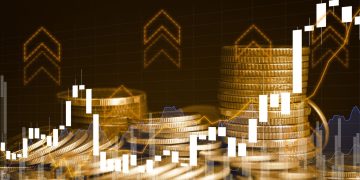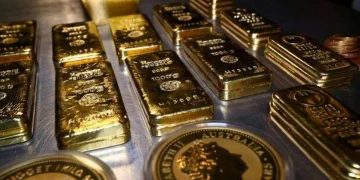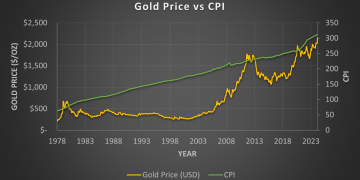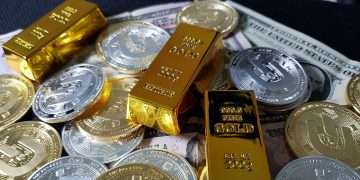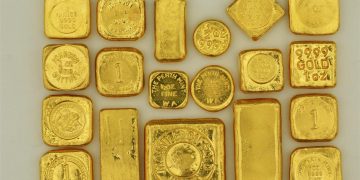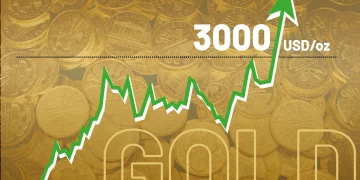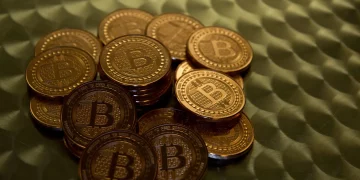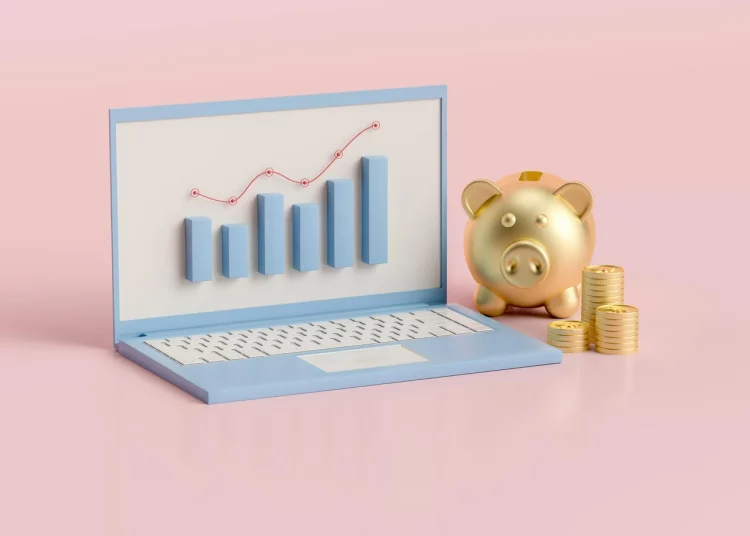Gold has long been regarded as a safe-haven asset, a refuge from the volatility of financial markets, particularly during times of economic uncertainty. History has shown that gold often performs well during financial crises, acting as a hedge against the devaluation of currencies, inflation, and stock market declines. By analyzing gold’s behavior during major global economic downturns like the 2008 Financial Crisis and the COVID-19 pandemic, we can gain valuable insights into its future role during global shocks. This article delves into gold’s historical performance during these crises, how historical data can guide future predictions, and the market trends that may emerge from future global economic shocks.
Analyzing Gold’s Behavior During Major Global Economic Downturns
The 2008 Financial Crisis: A Turning Point for Gold
The 2008 Financial Crisis was a watershed moment for global economies, financial systems, and markets. It was triggered by the collapse of Lehman Brothers, a leading global investment bank, which set off a chain reaction of credit defaults, banking failures, and stock market turmoil. The crisis resulted in widespread economic recession, global financial instability, and a dramatic loss of investor confidence in traditional financial assets.
Amid this turbulence, gold emerged as a vital asset class. Gold prices soared as investors sought refuge from the plummeting stock market and volatile currencies. At the beginning of 2007, gold traded at approximately $650 per ounce. By the time the crisis reached its peak in 2008, gold had surged to nearly $1,000 per ounce, with its role as a safe-haven asset gaining prominence.
The catalyst for gold’s performance during the 2008 crisis can be attributed to several factors:
- Fear of Inflation: The massive monetary stimulus measures employed by central banks, such as the U.S. Federal Reserve’s quantitative easing program, raised concerns about future inflation. This made gold an attractive hedge against the risk of devaluation of fiat currencies.
- Declining Confidence in Paper Assets: The collapse of several large financial institutions led to a massive erosion of confidence in the stock market and other paper assets. Investors turned to gold, which has historically been a store of value, to preserve their wealth.
- Global Uncertainty: The 2008 crisis affected markets worldwide, creating significant geopolitical and financial instability. Gold’s perceived status as a global safe-haven asset only increased as a result.
During this period, central banks also began reducing their sales of gold and started buying it in greater quantities, which contributed to the rise in gold prices. The 2008 Financial Crisis reaffirmed gold’s position as a trusted asset in times of financial turmoil, making it a preferred choice for investors looking for stability in an unpredictable world.
COVID-19 Pandemic: Another Surge for Gold
In 2020, the world was faced with an unprecedented economic shock: the COVID-19 pandemic. Much like the 2008 Financial Crisis, the pandemic triggered massive disruptions across global markets. Governments worldwide enacted lockdowns, and industries across the globe were forced to shut down, leading to severe economic contraction.
The pandemic created an environment of uncertainty and fear, similar to what was witnessed during the 2008 crisis. As stock markets tumbled, central banks implemented drastic monetary measures to counter the economic damage. The U.S. Federal Reserve slashed interest rates to near zero and injected trillions of dollars into the economy through various stimulus programs. Governments around the world followed suit with their own fiscal interventions.
In response to these events, gold’s price soared once again. By mid-2020, gold had surpassed its previous all-time high of $1,900 per ounce, reaching an unprecedented $2,070 per ounce in August 2020. Gold’s performance during the COVID-19 pandemic was driven by several factors:
- Inflation Fears and Currency Devaluation: Similar to the 2008 crisis, the massive government stimulus and monetary easing raised concerns about long-term inflation and the devaluation of fiat currencies. As a result, many investors turned to gold as a store of value and a hedge against inflation.
- Uncertainty Over Global Economic Recovery: The pandemic triggered significant uncertainty about the global economic recovery. Gold is often seen as a safe haven in times of uncertain economic futures, and many investors sought protection from potential losses in other markets.
- Interest Rates and Real Yields: The global interest rate cuts and the low yields on traditional fixed-income assets (such as government bonds) also contributed to the surge in gold prices. With real yields remaining negative, gold became more attractive compared to other non-yielding assets.
The pandemic once again demonstrated gold’s resilience during times of unprecedented financial and geopolitical uncertainty. Despite the challenges posed by the COVID-19 crisis, gold maintained its role as a safe-haven asset, continuing to serve as a hedge against both market volatility and inflationary risks.
How Historical Data Can Help Predict Gold’s Future Role in Financial Crises
Historical data on gold’s performance during past economic crises provides valuable insights into how it might behave during future downturns. By analyzing the factors that influenced gold’s price movements during past crises, we can identify patterns that may help predict its future role during global shocks.
Gold as a Hedge Against Inflation and Currency Devaluation
In both the 2008 Financial Crisis and the COVID-19 pandemic, gold performed well due to its status as a hedge against inflation and currency devaluation. In times of economic distress, central banks often resort to aggressive monetary policies, such as cutting interest rates and increasing the money supply through quantitative easing programs. These actions increase the risk of currency devaluation and inflation, which makes gold more attractive as a store of value.
In the future, similar monetary interventions could drive further demand for gold as a hedge. Investors may once again turn to gold to protect their portfolios against the risk of inflation and currency weakness, especially if governments continue to rely on fiscal stimulus measures.

Gold as a Safe Haven During Geopolitical and Economic Uncertainty
Both the 2008 Financial Crisis and the COVID-19 pandemic highlighted gold’s role as a safe haven during periods of geopolitical and economic instability. In future global shocks, such as political unrest, trade wars, or future pandemics, gold is likely to once again attract investors seeking stability.
The uncertainty caused by global shocks often leads to heightened risk aversion. Investors, particularly those who are risk-averse, are likely to seek safe-haven assets like gold, which has proven its ability to preserve wealth during periods of crisis. Historical data suggests that gold’s demand during such periods could increase, driving up prices.
Gold’s Role in Portfolio Diversification
Gold has long been an essential component of a diversified investment portfolio. During times of economic downturns, traditional asset classes, such as stocks and bonds, often experience significant declines. Gold, on the other hand, tends to hold its value or appreciate, making it a key asset for portfolio diversification. The historical data from both the 2008 Financial Crisis and the COVID-19 pandemic underscores this point.
Investors looking to protect their portfolios from the risk of losses in traditional asset classes are likely to continue turning to gold in the future. As a result, gold’s role in investment portfolios will likely remain strong, especially in times of global economic uncertainty.
Market Trends That May Emerge from Future Global Shocks
While we cannot predict the exact nature of future global shocks, we can identify potential market trends that may emerge based on historical patterns.
Increased Demand for Safe-Haven Assets
In the wake of future global economic downturns, the demand for safe-haven assets like gold is likely to increase. Investors, particularly those in developed markets, may seek to safeguard their wealth by allocating more funds to gold and other precious metals. The rise in demand could lead to an increase in gold prices, as was seen during both the 2008 Financial Crisis and the COVID-19 pandemic.
Gold’s Role in Central Bank Reserves
Central banks have historically been net buyers of gold during times of crisis. In the aftermath of future financial crises, it is likely that central banks will once again increase their gold holdings as part of their strategy to hedge against economic uncertainty and diversify their foreign exchange reserves. This trend could further support gold prices and cement its status as a critical asset for global economic stability.
Gold as an Inflation Hedge in a Low-Interest Rate Environment
With the global trend toward low or negative interest rates, investors may increasingly turn to gold as a hedge against inflation. The combination of low yields on government bonds and the risk of currency devaluation in the face of mounting government debt could drive further demand for gold as a store of value.
Conclusion
Gold has consistently proven its resilience and value during times of economic crises. Whether during the 2008 Financial Crisis or the COVID-19 pandemic, gold has demonstrated its ability to protect wealth, hedge against inflation, and serve as a safe-haven asset in times of financial turmoil. By analyzing historical data, we can gain valuable insights into how gold may behave during future global shocks and predict trends such as increased demand for safe-haven assets, a growing role in central bank reserves, and its continued role as a hedge against inflation. As we look to the future, gold’s status as a reliable asset during periods of economic uncertainty is likely to remain strong, making it an essential component of a diversified investment strategy in the 21st century.













